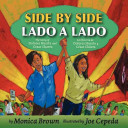
Every day, thousands of farmworkers harvested the food that ended up on kitchen tables all over the country. But at the end of the day, when the workers sat down to eat, there were only beans on their own tables. Then Dolores Huerta and Cesar Chavez teamed up. Together they motivated the workers to fight for their rights and, in the process, changed history. Award-winning author Monica Brown and acclaimed illustrator Joe Cepeda join together to create this stunning tribute to two of the most influential people of the twentieth century. Todos los dÍas, miles de campesinos cosechaban los alimentos que se servÍan en los hogares de todo el paÍs. Pero al terminar la jornada, cuando los campesinos se sentaban a comer, lo Único que habÍa en sus propias mesas era frijoles. Entonces, Dolores Huerta y CÉsar ChÁvez se unieron para motivar a los trabajadores a luchar por sus derechos y en el proceso, cambiaron el curso de la historia. La premiada autora Monica Brown y el aclamado ilustrador Joe Cepeda se unen para crear Éste impresionante tributo a dos de las personas mÁs influentes del siglo veinte.
- ISBN: 9780061227813
- Author: Brown, Monica
- Illustrator: Cepeda, Joe
- Published: 2009 , HarperCollins
- Themes: Farm workers, Helping, Migrant laborers
- Descriptors: Bilingual, Biography - Autobiography- Memoir, Intermediate (ages 9-14), Latinx in US, Nonfiction, Picture Book, Primary (ages 6-9), United States
- No. of pages: 32

Your question, about whose stories are missing, has been one that I have been pondering. Several recent books make me wonder about that question. People, especially women are profiled in several new books. It appears that there is a trend to tell those missing stories.
This beautifully crafted, bilingual biography by Monica Brown recounts the story of activists Cesar Chavez and his wife, Dolores Heurta , who worked tirelessly for civil rights “side by side.” Each double-page spread features text in both Spanish and English, with Huerta’s story on the left, and Chávez’s on the right. Cepeda’s brilliant illustrations powerfully portray the harrowing conditions that led to the farm workers civil rights movement such as a page depicting poisonous pesticides sprayed from an overhead plane while Chavez tries to run away, and in another, Chávez and Huerta lead a march over 300 miles long to call for better working and living conditions for farm workers.
I enjoyed this book very much for several reasons. In addition to being bilingual, beautifully illustrated, and rich with information about the Latino Civil Rights Movement, it told a story I did not know. I was aware of the life and work of Cesar Chávez, but knew very little about his wife, Dolores Huerta, co-founder of the United Farm Workers and integral to success of the Latino Civil Rights Movement. Monica Brown, during a recent presentation at the University of Arizona, explained what inspired this book, “In Cesar, Dolores saw a man of hope and peace who dedicated his work and ultimately, his life itself, to helping others. In Dolores Huerta, I see a personal hero—a woman who, at age 80, has not stopped her struggle for justice.”
I wonder what other important stories told through children’s literature or in other history texts children and youth take up depict important “behind the scenes” individuals and groups? Are representations of women who worked “side by side” with their famous husbands or fathers or lovers, etc… now more fairly represented in the telling of history than before? And most of all, I wonder whose stories are missing?